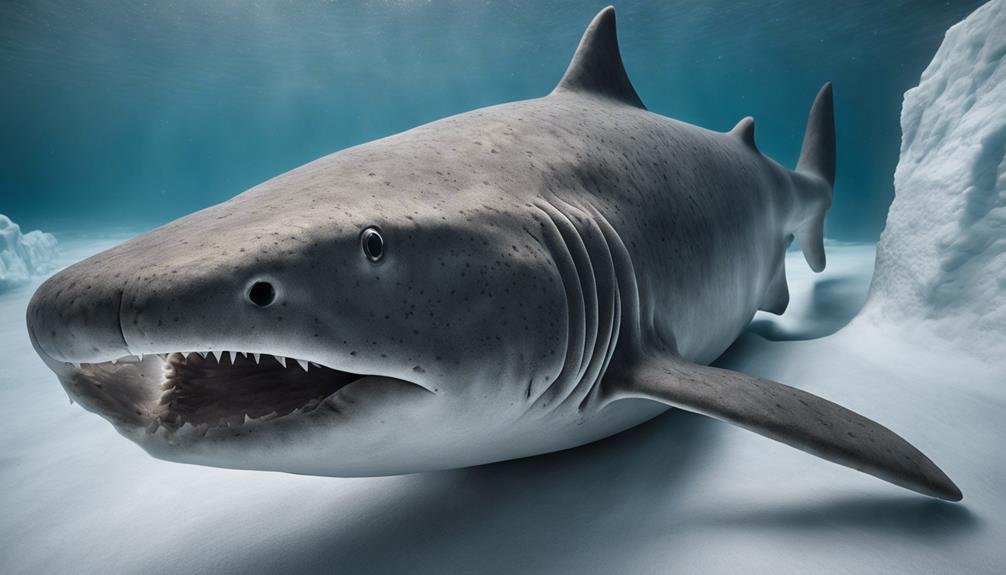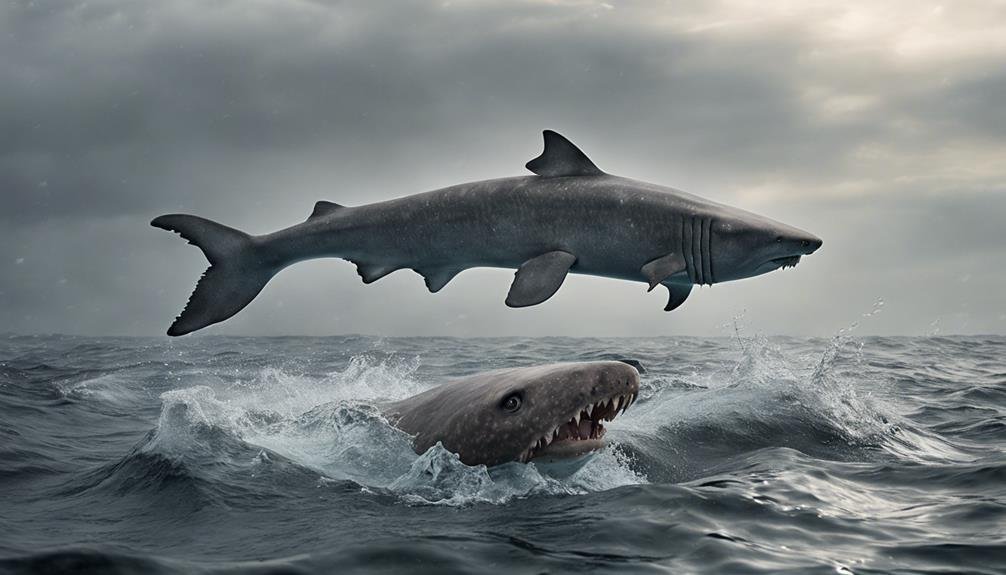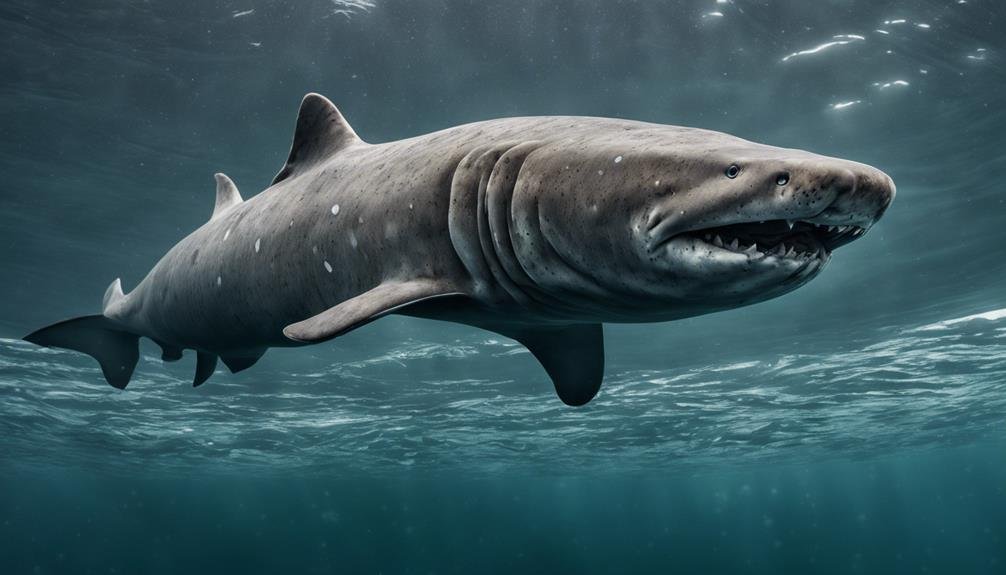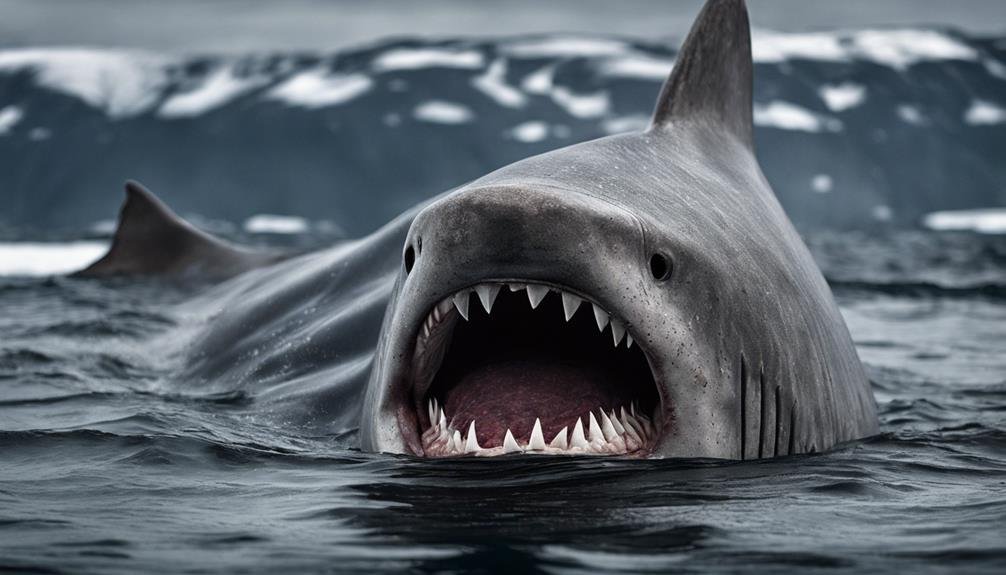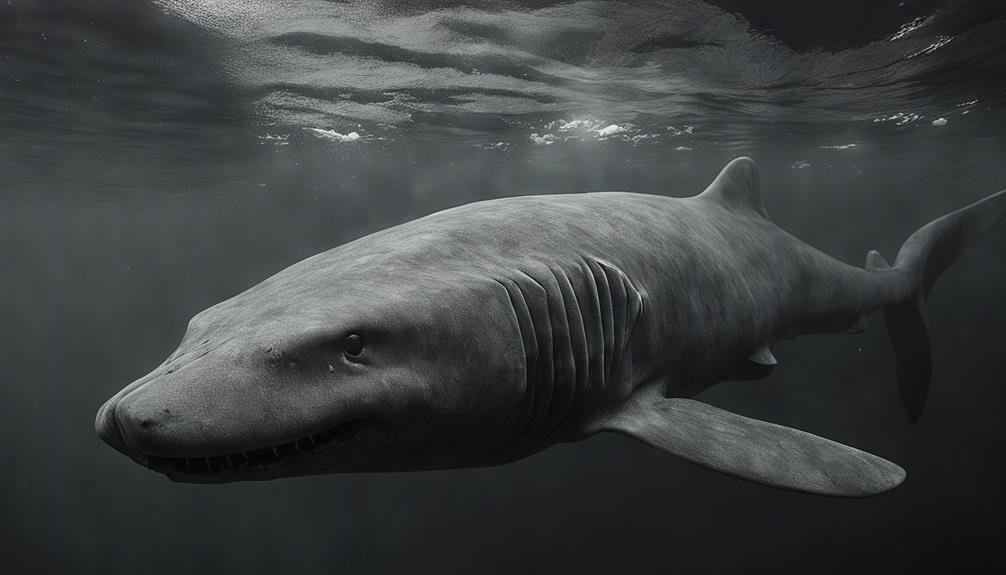What mysteries do the ancient Greenland sharks hold within the icy depths of the Arctic? These formidable creatures, often shrouded in the darkness of the ocean’s abyss, have fascinated scientists and oceanographers for years. But what is it about these elusive giants that captures our imagination?
The Greenland shark is a marvel of nature, swimming silently through the Arctic waters. These sharks are notable for their immense size, with some individuals reaching lengths of up to 6.4 meters and weights that rival that of a small car. Their ability to thrive in the bone-chilling temperatures of the Arctic, a feat achieved through a unique biochemistry that includes toxic compounds in their flesh, sets them apart from most marine life. Despite their sluggish appearance, Greenland sharks have a diverse diet and employ intriguing survival strategies. Perhaps the most captivating aspect of these ancient sharks is their incredibly long lifespan, with some individuals rumored to live for centuries. This longevity raises compelling questions about their secrets to surviving in one of the planet’s most extreme environments.
Understanding the Greenland shark offers a high-level overview into not just the biology of these enigmatic creatures but also the ecosystems they inhabit and the broader narrative of life in the Earth’s oceans. Through studying these ancient mariners, we gain insights into the intricate balance of marine biodiversity and the evolutionary adaptations that have enabled life to flourish in the harshest of conditions.
Key Takeaways
Key Takeaways:
- The Greenland shark exhibits unique adaptations such as exceptional diving abilities and resilience in cold Arctic waters.
- These sharks pose no significant threat to humans due to their docile nature.
- Their slow growth rate and deep-sea habitat preferences highlight their vulnerability, especially with the looming threat of climate change.
- Conservation efforts for the Greenland shark are crucial for the preservation of this species and the overall health of marine ecosystems they inhabit.
Scientific Classification
The Evolutionary Marvel of the Greenland Shark
The
Greenland Shark (
Somniosus microcephalus), residing within the
Somniosidae family, epitomizes the marvels of evolutionary adaptation. Previously referred to as
Squalus microcephalus, its reclassification underscores a significant journey through scientific understanding. Situated within the
Squaliformes order, these sharks are a part of the
Elasmobranchii subclass under the
Chondrichthyes class. This classification places them amidst the fascinating group of cartilaginous fish, a testament to their unique biological makeup. Belonging to the
Chordata phylum, these creatures are defined by their dorsal nerve cord, highlighting their evolutionary complexity.
The
Greenland Shark‘s Unique Place in the Aquatic World
As one of the most formidable predators in its environment, the
Greenland Shark stands out not just for its size but for its extraordinary longevity. Techniques like radiocarbon dating have peeled back the layers of mystery surrounding these enigmatic giants, revealing their slow growth rates and remarkable adaptability to the frigid depths of the ocean. The application of such scientific methods hasn’t only shed light on the lifespan of these sharks but also on their crucial role within the marine ecosystem. Their presence in the deep sea offers invaluable insights into the intricate web of marine biodiversity and the ecological balance of underwater life.
Contribution to Marine Biodiversity Understanding
The study of the
Greenland Shark extends beyond mere fascination, advancing our comprehension of marine ecosystems. Through the lens of this species’ unique characteristics and survival strategies, scientists can explore broader ecological dynamics. The
Greenland Shark serves as a living link to the evolutionary past, offering clues to the adaptive mechanisms of marine species in extreme environments. Its significance in the scientific community isn’t only due to its intriguing anatomical and physiological features but also because it illuminates the paths of ecological interaction and evolutionary survival within the vast and mysterious oceanic realm.
Habitat
Greenland Shark Habitats: An Overview
Greenland sharks are fascinating creatures that thrive in the
Northern Atlantic and Arctic waters, a testament to their extraordinary adaptability. These sharks have a unique presence in the ocean, favoring the colder and deeper parts of the marine world. Their ability to inhabit such a broad range of depths and temperatures is truly remarkable.
Diverse Depths
One of the most striking aspects of the Greenland shark’s habitat is its ability to exist at various depths. These sharks can be found from the ocean’s surface down to an impressive 3,937 feet. This wide vertical range showcases their exceptional adaptations to life in the ocean’s different layers.
Cold Water Survival
The temperature preference of Greenland sharks is another key part of their habitat. They thrive in waters that range from 34 to 68 degrees Fahrenheit. This preference for colder temperatures highlights their specialized physiological traits that enable survival in extreme conditions.
Wide Geographical Range
The geographical spread of Greenland sharks is quite extensive. They’ve been observed in locations as varied as the icy Arctic waters to more temperate areas around France, Portugal, and even North Carolina. This wide range underscores their migratory behavior and adaptability to different marine environments.
Shoreline Ventures
Interestingly, Greenland sharks occasionally venture closer to the shore. This behavior suggests a complex pattern of movement that might be linked to searching for food or warmer waters during certain times of the year. Their proximity to the shore adds another layer to their intriguing behavior and adaptability.
Diet
The Greenland Shark’s Varied Menu
Delving into the dietary habits of the
Greenland shark reveals their remarkable adaptability and role in the oceanic food web. These sharks feast on a wide array of marine life, demonstrating their prowess as
apex predators. Their menu is as diverse as the ocean itself, featuring
fish,
squid,
carrion,
crustaceans,
seabirds, and occasionally
terrestrial mammals that inadvertently enter their waters. Insights from stomach content analyses paint a picture of a creature that doesn’t discriminate between living or dead meals, highlighting their
scavenging nature.
Stealthy Hunters of the Deep
Despite their slow, languid movements,
Greenland sharks are surprisingly effective at hunting. Observations have shown these sharks employing stealth tactics to ambush their prey, such as
seals. This behavior contradicts their sluggish reputation, as they can exhibit bursts of speed or stealth when necessary. Their methodical approach to hunting, combined with their broad diet, underscores their importance as both
predators and
scavengers in maintaining the balance within their marine ecosystem.
Behaviour
Adaptive Predatory Techniques
Greenland sharks exhibit a fascinating ability to adjust their hunting tactics. While often perceived as slow, these sharks can execute unexpected accelerative maneuvers to catch their unsuspecting prey. This adaptability is particularly evident when they hunt seals, using the element of surprise to their advantage. Their hunting prowess underscores a significant adaptation to the challenging conditions of their habitat.
Energy Conservation Strategies
One of the most notable characteristics of Greenland sharks is their leisurely pace, moving on average at speeds less than 2 miles per hour. This deliberate movement isn’t just a product of their environment but a strategic choice to conserve energy in the nutrient-sparse depths of the Arctic and North Atlantic oceans. This energy-efficient lifestyle ensures their survival in the harsh conditions of their natural habitat.
Dietary Flexibility
The diet of Greenland sharks is remarkably diverse, encompassing fish, squid, and even carrion. This dietary flexibility is a testament to their adaptability, allowing them to thrive in a habitat where food sources can be both scarce and unpredictable. Their ability to scavenge provides a crucial advantage, ensuring they’ve access to a steady food supply in the deep sea.
Interaction with Humans
Despite their imposing size, Greenland sharks exhibit a notable lack of aggression towards humans. This behavior is intriguing, considering their dominance in the frigid waters they inhabit. Their non-aggressive nature towards humans highlights the complexity of their behavior and suggests a specific ecological balance within their natural environment.
Through these distinct behaviors, Greenland sharks demonstrate a remarkable capacity for adaptation, enabling them to navigate the challenges of their deep-sea habitat successfully.
Conservation
The Plight of the Greenland Shark
The
Greenland shark, a majestic yet enigmatic creature, swims in the cold waters of the Arctic and North Atlantic oceans. Recognized for their extraordinary longevity, these sharks can live for centuries, making them one of the planet’s most ancient marine species. Unfortunately, they’re listed as
near-threatened by the
International Union for Conservation of Nature (IUCN).
Challenges in Conservation Efforts
One of the primary obstacles in the path to protecting the Greenland shark is their slow biological cycle. They grow at a glacial pace, reach maturity late in their lives, and have a very low birth rate. These factors combined make them particularly susceptible to the dangers of overexploitation. Historically, they were hunted for their
liver oil up until the 1960s, but today, they face a new threat:
bycatch. Each year, around
1,200 Greenland sharks are unintentionally captured in nets by small-scale fisheries in the Arctic. This accidental capture significantly endangers their population.
Toxicity and Ecosystem Role
Another layer of complexity in their conservation is the shark’s flesh, which is laden with high levels of
pollutants. This not only indicates the shark’s position as an apex predator but also points to the broader environmental issues affecting marine life. The toxic nature of their flesh, a result of bioaccumulation, serves as a stark reminder of the interconnectedness of marine ecosystems and the importance of maintaining their health for the survival of species like the Greenland shark.
Forward Steps in Research and Protection
The cornerstone of effective conservation is comprehensive research. Understanding the
Greenland shark’s behavior, habitat, and ecological role is crucial. Such knowledge can inform targeted conservation strategies, aiming to reduce the impacts of overfishing and bycatch. Through dedicated monitoring and the implementation of science-based management plans, there’s hope for the preservation of this remarkable species.
In the fight to secure a future for the Greenland shark, every action counts. From mitigating pollution to enforcing stricter fishing regulations, the path to conservation is multifaceted. It requires the collaboration of governments, NGOs, and the global community to ensure that these ancient sharks continue to thrive in our oceans.
Climate Change Impacts
Climate Change Impacts on the
Greenland Shark
The
Greenland Shark, an ancient species thriving in the cold waters of the Arctic, faces a multitude of threats due to climate change. This shift in the planet’s climate not only affects the direct surroundings of these remarkable creatures but also poses significant risks to their survival and the broader marine ecosystems they’re part of. Here, we delve into the various challenges climate change presents to the
Greenland Shark, emphasizing the need for action to preserve their environment.
Sea Level Rise and Habitat Disruption
One of the critical effects of climate change is the rise in sea levels, which can significantly disrupt the coastal ecosystems that are home to the
Greenland Shark. This change may modify their traditional hunting areas, potentially leading to a decrease in prey availability. The alteration of their habitat emphasizes the need for urgent measures to mitigate climate change effects on marine life.
Impact on Marine Biodiversity
The loss of biodiversity, driven by factors such as deforestation and climate change, severely affects marine ecosystems. For the
Greenland Shark, this biodiversity loss could mean changes in the food web dynamics, possibly altering their role within their habitat. The ripple effects of these changes on marine biodiversity underline the interconnectedness of ecosystems and the importance of maintaining them.
Threats from Plastic Pollution
Plastic pollution in the oceans is another significant threat, affecting a wide range of marine species, including the
Greenland Shark. The dangers of ingestion and entanglement with plastic debris highlight the broader environmental challenges these sharks face, compounded by climate change. Addressing plastic pollution is crucial in protecting the resilience of marine species.
Arctic Ice Loss and Habitat Changes
The warming of the planet contributes to a significant loss of ice cover in the Arctic, the primary habitat of the
Greenland Shark. This loss forces these sharks to migrate to new areas in search of suitable living conditions, fundamentally altering their way of life. The impact of melting Arctic ice on the
Greenland Shark showcases the critical need for efforts to combat global warming and preserve Arctic habitats.
Other Interesting Facts
Toxic Delicacy: The Culinary Challenge of Greenland Shark Meat
Greenland sharks possess a peculiar feature that sets them apart in the culinary world: their meat is laced with neurotoxins. This trait makes their consumption a risky endeavor for both humans and animals alike, such as sled dogs, unless it undergoes meticulous preparation processes. This necessity has given birth to specialized culinary traditions in areas where these sharks are prevalent, highlighting the complex dance between human culture and the natural world.
The Slow-paced Hunters of the Deep
Despite their seemingly sluggish movement, cruising through the ocean at a mere 0.3 meters per second, Greenland sharks are anything but inefficient. This slow speed, which has led to them being nicknamed ‘sleepers,’ belies their effectiveness as predators in the icy depths they call home. Their methodical pace is a testament to their adaptability and success in the harsh environments of the Arctic waters.
Masters of Longevity: Greenland Sharks’ Lifespan
Among the marine community, Greenland sharks hold the record for longevity, with potential lifespans ranging between 252 to 512 years. This extraordinary age is made even more fascinating by their unique eye structure. Their lens, composed of transparent tissue, serves as a critical tool for scientists aiming to accurately determine their ages, offering profound insights into the mysteries of marine longevity and life strategies.
Deep Sea Dwellers: Exploring the Depths
Greenland sharks exhibit an impressive capability to dive to remarkable depths, reaching up to 2,200 meters below the ocean’s surface. Their ability to thrive in such extreme conditions throughout the icy Arctic waters further solidifies their reputation as one of the most intriguing and formidable creatures in the oceanic realm.
What is the relationship between Greenland sharks and beluga whales in the Arctic?
In the Arctic, Greenland sharks and beluga whales have an interesting relationship. Research suggests that beluga whales may serve as a food source for Greenland sharks, as remains of beluga whales have been found in the stomachs of the sharks. To learn about beluga whales in the Arctic, it is important to understand their ecological interactions with other species.
Frequently Asked Questions
What Are Some Fun Facts About the Greenland Shark?
Q: How large can Greenland sharks grow?
A:
Greenland sharks can reach lengths of up to 24 feet, making them one of the largest shark species.
Q: What is the typical diet of a Greenland shark?
A:
Greenland sharks primarily feed on fish but have also been known to eat seals and even remains of polar bears, indicating their opportunistic feeding behavior.
Q: How old can Greenland sharks live to be?
A: Studies have shown that
Greenland sharks can live for hundreds of years, with some individuals estimated to be over 400 years old, making them the longest-living vertebrates known on Earth.
Q: Where can Greenland sharks be found?
A:
Greenland sharks are native to the cold waters of the North Atlantic and Arctic Oceans, typically residing in deep waters.
Q: Do Greenland sharks have any natural predators?
A: Due to their size and the depths at which they reside, adult
Greenland sharks have no natural predators. Their slow-moving nature and the cold, deep environment they inhabit make them a challenging target for potential predators.
Why Do Greenland Shark Live so Long?
Q: Why do Greenland sharks have such long lifespans?
A:
Greenland sharks possess remarkable longevity due to a combination of factors. Their
cold-water metabolism is significantly slower than that of sharks in warmer climates, leading to a delayed but steady growth rate. They have also developed
genetic adaptations that enable them to resist the diseases and deteriorations that come with aging. Living in the
deep sea, where there are fewer predators, contributes to their survival, as does a
unique diet that supports their health in extreme conditions. These elements together allow Greenland sharks to live for centuries.
Are Most Greenland Sharks Blind?
Q: Are most Greenland sharks blind?
A: No, most
Greenland sharks are not blind. They may suffer from visual impairment due to
parasitic copepods that attach to their eyes, yet they adeptly navigate the Arctic waters using their other senses. This adaptation is of significant interest to researchers studying their longevity and unique lifestyle in deep sea environments.
Is the Greenland Shark Poisonous?
Is the Greenland Shark Poisonous?
Yes, the
Greenland shark is considered poisonous. This is due to the accumulation of environmental toxins and high levels of
TMAO (trimethylamine N-oxide) in its flesh. These factors make consuming the shark potentially risky. The shark’s unique diet and indigenous hunting practices contribute to its toxicity, making it different from other species. Proper cooking methods can reduce the risk of poisoning.
How Do Bowhead Whales and Greenland Sharks Adapt to Cold Arctic Waters?
Bowhead whales and Greenland sharks have extraordinary adaptations to survive the frigid Arctic waters. Bowhead whales possess a thick layer of blubber, insulating them against freezing temperatures. Greenland sharks live in deep, cold waters with slow metabolisms. For more on these adaptations, valuable *bowhead whale information* offers further insights into their remarkable survival strategies.
Conclusion
In summarizing the characteristics and significance of the
Greenland shark, it’s clear that this species stands out for its remarkable adaptations. These include its impressive diving capabilities and its ability to thrive in the frigid waters of the Arctic.
Despite their considerable size, these sharks aren’t known to be a danger to humans, largely due to their docile nature. However, concerns have been raised about their vulnerability, particularly because of their slow growth rate and preference for deep-sea environments. This vulnerability is compounded by the potential impacts of climate change, which underscore the need for targeted conservation efforts.
Protecting the
Greenland shark isn’t only vital for preserving this unique species but also for maintaining the ecological balance of the marine ecosystems they’re a part of.
